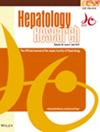Quantitative evaluation of tumor signal heterogeneity on gadoxetic acid-enhanced magnetic resonance imaging as a predictor of postoperative survival and antitumor immunity in hepatocellular carcinoma
Abstract
Aim
We investigated the efficacy of quantitative evaluation of tumor signal heterogeneity on gadoxetic acid-enhanced magnetic resonance imaging (EOB-MRI) to predict prognosis and antitumor immunity in patients with hepatocellular carcinoma (HCC) undergoing liver resection.
Methods
A total of 297 patients who underwent curative resection for primary HCC were included. Tumor signal heterogeneity in the hepatobiliary phase (HBP) of EOB-MRI was quantified as the coefficient of variation (CV), calculated as the standard deviation divided by the mean signal intensity. Patients were classified into homogeneous (low CV) and heterogeneous (high CV) groups based on a cutoff value of 0.16 from receiver operating characteristic curve analysis. Tumor-infiltrating CD4+ and CD8+ T cells and PD-L1 expression were assayed by immunohistochemistry, and their associations with tumor signal heterogeneity were evaluated.
Results
Among the 297 patients, 116 (39.1%) were classified into the heterogeneous group. The overall survival (OS) and recurrence-free survival (RFS) rates were significantly lower in the heterogeneous group (p < 0.001 for both). Multivariate analysis identified heterogeneous group as an independent prognostic factor for OS and RFS (p < 0.001 and p = 0.012, respectively). Extrahepatic recurrence was significantly more frequent in the heterogeneous group (18.1% vs. 7.7%, p = 0.024). CD4+ and CD8+ T cells were significantly decreased, and the PD-L1 positivity rate was significantly lower in the heterogeneous group (p < 0.001 for all).
Conclusions
The quantitative evaluation of tumor signal heterogeneity in the HBP of EOB-MRI using CV is useful for predicting postoperative prognosis in patients with HCC. Tumor signal heterogeneity may also reflect impaired local immunity and an immunologically “cold” tumor.

 求助内容:
求助内容: 应助结果提醒方式:
应助结果提醒方式:


